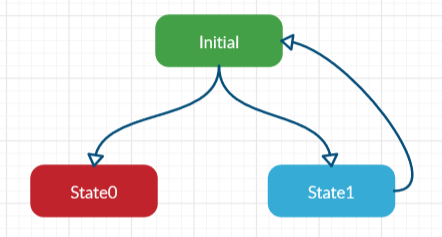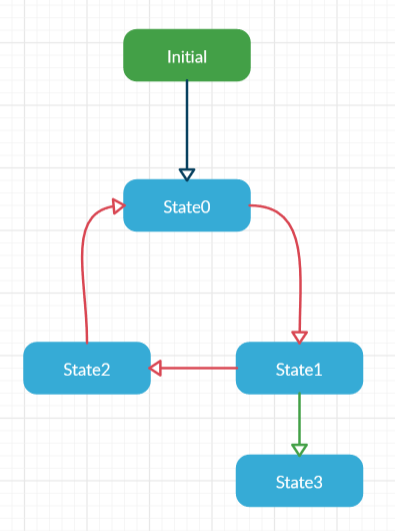Dynamic systems
- A simple state machine and several properties
- Making the family model dynamic
- Transition system
- Alloy modules
- Case studies
- Acknowledgments
A simple state machine and several properties
A state machine is a directed graph that models how a system moves from State to State as it executes. It has one or more marked Initial (or starting) states, and edges connecting each state to its successor(s). An initial state can be the successor of another state. Let’s write the following predicates that describe different properties of state machines:
there is at least one initial state
a deterministic machine, in which there is one initial state and each state has at most one successor
a nondeterministic machine, in which there are multiple initial states, or where at least one state has more than one successor, or both
a machine with at least one state that is unreachable from any initial state
a machine where all states are reachable from some initial state (it need not be the same initial state for each one)
a connected machine in which every state is reachable (along the successor relation) from every other state
a machine with a deadlock: a machine with a state that is reachable from an initial state, but has no successors. For example,

shows a state machine with
State0deadlocked.a machine with a livelock: a machine where there exists some cycle reachable from an initial state and a state (the “livelocked” state) reachable from the cycle that’s not part of the cycle. Note that this livelocked state cannot be reached at any point before reaching the cycle or in the cycle itself. For example,

shows a state machine with
State3livelocked by the cycle starting inState0.
Code
- Alloy anaylizer version:
- Forge version:
Making the family model dynamic
We can make the family model dynamic by associating relation with states. Let’s cosider a subset of the family model:
abstract sig Person {
spouse: lone Person,
}
sig Man, Woman extends Person {}
If we were to make the spouse relation to also consider states, we could simulate that in one state people are married and another they are not. So the above model would include State and have a different spouse relation:
sig State {
successor : set State
}
abstract sig Person {
spouse: Person lone -> State,
}
sig Man, Woman extends Person {}
Now whether people are married is dependent on states: in state s people p and q are married if (p+q).spouse.s is non-empty. With this condition we can define an operation that simulates a transition, i.e., a change of states from “these people are not married” to “these people are married”:
pred getMarried [p,q: Person, s,s': State] {
-- Pre-condition: they must not be married
no (p+q).spouse.s
-- Post-condition: After marriage they are each other's spouses
q in p.spouse.s'
p in q.spouse.s'
}
The above (together with an example run command) can be found here.
Transition system
Relying on an ordering of the states we can proceed to specify transition systems. A transition system is defined in terms of:
- Initial conditions to be satisfied
- A transition relation than when satisfied changes the system to the next state
Modelling the family model as a transition system defined by the getMarried operation, we can define as initial conditions that nobody is married, i.e.
pred init [s : State] {
no spouse.s
}
and as transitien relation a predicate stating that two people get married, i.e.
pred transition [s, s' : State] {
some p, q : Person | getMarried[p,q, s, s']
}
and finally the transition system states that given that the initial conditions are met, at every state but the final a transition happens between a state and its successor:
pred system {
init[first]
all s : State - final | transition[s, s.successor]
}
The above specifies all possible executions of the system from a state that satisfies the init condition.
Frame conditions
It’s necessary to restrict operations to only change the relations they refer to. For example, people getting married should not affect the relations about people having children or about being alive. Doing so is called establishing “frame conditions”, i.e. what exactly in the system can be affected by an operation.
Considering that the Person signature is now defined as
abstract sig Person {
spouse: Person lone -> State,
children: set Person -> State,
alive: set State
}
we establish frame predicates for each of the relations:
pred noChildrenChangeExcept[ps : set Person, s, s' : State] {
all p : Person - ps | p.children.s = p.children.s'
}
pred noSpouseChangeExcept[ps : set Person, s, s' : State] {
all p : Person - ps | p.spouse.s = p.spouse.s'
}
pred noAliveChange[s, s' : State] {
alive.s' = alive.s
}
and define operations which respect frame conditions:
pred getMarried [p,q : Person, s, s' : State] {
-- pre-condition: not married yet
no (p+q).spouse.s
-- post-condition: they're married
q in p.spouse.s'
p in q.spouse.s'
-- frame conditions
noChildrenChangeExcept[none, s, s']
noSpouseChangeExcept[p+q, s, s']
noAliveChange[s, s']
}
pred isBornFromParents [p : Person, m : Man, w : Woman, s, s': State] {
-- pre-condition :
m+w in alive.s
p not in alive.s
-- post condition:
alive.s' = alive.s + p
m.children.s' = m.children.s + p
w.children.s' = w.children.s + p
--frame condition:
noChildrenChangeExcept[m+w, s, s']
noSpouseChangeExcept[none, s, s']
}
Code
- Family model as transition system
- Family model as transition system with tracking of operations
- Family model as transition system with tracking of operations and using util for ordering State
- A complete family model transition system with several invariant checks. Note that the transition system is defined for the
Timesignature, which is guaranteed to be ordered by theorderingmodule of Alloy Analyzer.
Alloy modules
Case studies
- Autonomous Rovers
- Hotel Lock System
Acknowledgments
Thanks to Tim Nelson for sharing examples about the state machine model. Thanks to Cesare Tinelli for the family model material, itself based on the original Alloy model by Daniel Jackson distributed with the Alloy Analyzer.